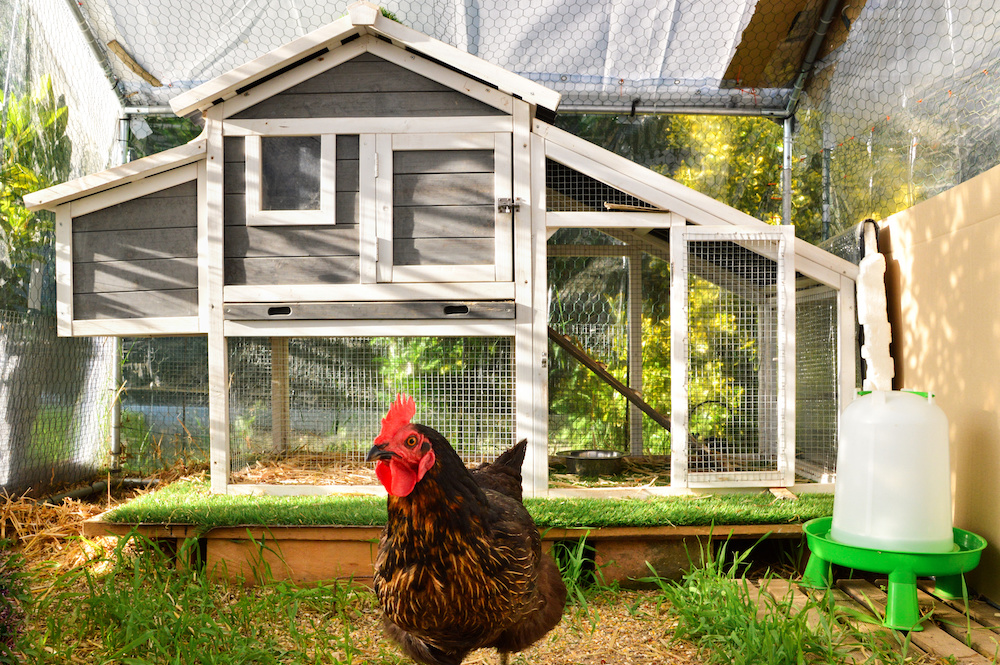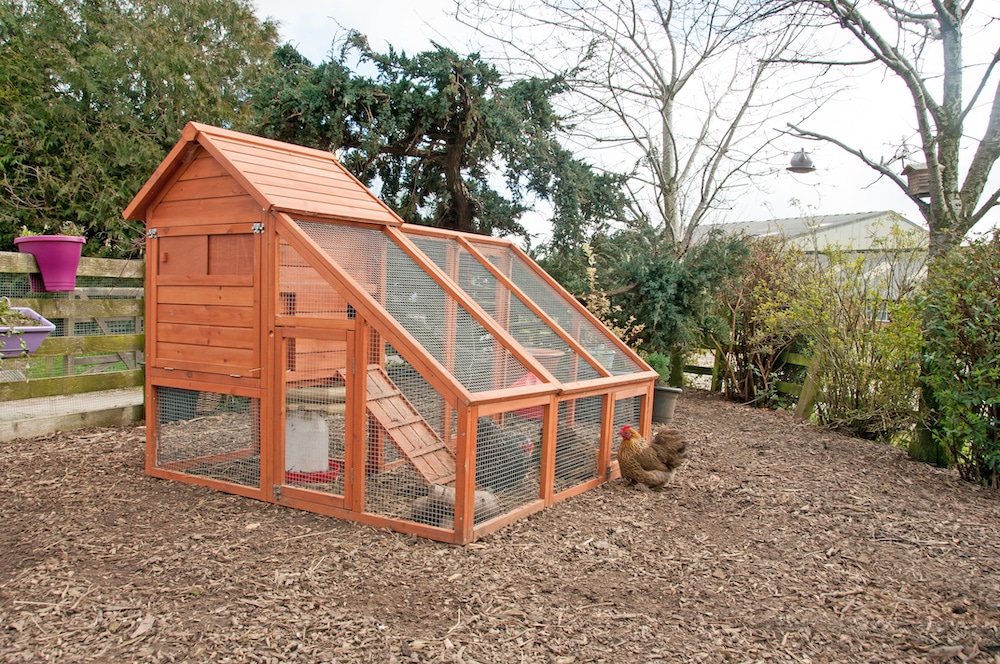Just like you, your flock benefits from a well-ventilated home. Chickens are amazing producers of moisture and ammonia which can be detrimental to their health. Therefore, you should make sure that your chicken coop gets enough fresh air and ventilation all year round. Yep, even in winter.
The question, though, is how much ventilation should a coop need? Well, it depends on a variety of factors.Â
In this guide, learn everything about chicken coop ventilation, why it’s needed, and how you can maintain a good amount of airflow in the coop.
Coop Ventilation and Why It Is Important
There are several reasons why ventilation for chicken coops is very important.
- It keeps the humidity low.
As mentioned, chickens produce incredible amounts of water vapor that contribute to a higher moisture content inside the coop. High humidity levels can lead to serious problems, such as frostbite during winter, illness, and even death.
There are two ways that chickens add or increase humidity in the coop. One is through normal breathing or respiration, and another is through droppings. The only way to keep humidity levels in the coop under control is with sufficient chicken coop vents.
- It keeps chickens cool.
Although they are very adaptable to weather changes, chickens perform at their best at around 75 degrees Fahrenheit and below. In the summer months, consistently high temperatures can cause “heat stress” and overheating in chickens.Â
These can lead to different health issues, such as dehydration. It can even halt their egg-laying process. That’s because, in the heat, chickens reserve their energy and stop laying eggs as it is taxing in their bodies.
- Ventilation dries out ammonia.
Aside from water vapor, chickens also produce lots of ammonia through droppings. Unfortunately, ammonia fumes can cause serious damage to their respiratory tract.
Proper ventilation is necessary to remove heat from the coop and eliminate ammonia fume. Furthermore, it supplies oxygen-laden fresh air that removes dust particles and other harmful pollutants in the air.
When to Ventilate?
Since chickens produce moisture, ammonia, and heat continuously every day, their home needs to have good ventilation all the time. It doesn’t matter if it’s summer or winter, your flock will benefit from a good amount of airflow.
Of course, during extreme weather conditions like a storm, you can temporarily shut down some ventilation, such as the chicken coop roof vent or windows to prevent cold drafts.
How Much Coop Ventilation Is Needed? Factors To Consider
“How much ventilation should a coop need?†is a tricky question. In general, a chicken coop requires three to four square feet of ventilation in cold weather. In summer, it needs more. Nonetheless, different factors affect the degree of chicken coop venting you need.Â
Bedding
If you’re using anything organic for your chicken bedding, such as wood shavings, hemp, and straw, the coop needs to have more ventilation as these materials tend to absorb and retain a lot of moisture and gas.Â
Therefore, during hot weather, it’s best to use inorganic bedding such as sand. Sand dries the chicken coop more quickly, reducing the amount of moisture and ammonia fumes in the coop.
Related: Best Chicken Bedding Materials
Frequency of Coop Cleaning
How often you clean your chicken coop is another determining factor for the amount of ventilation it requires.Â
Frequently changing the litter or removing droppings, which are the major sources of fumes and moisture, reduces the need for more ventilation. Additionally, if you’re using a dropping board underneath the roosting bar, the less ventilation your coop requires.
Location
If where you live has a hot climate all year round, consider an open-wall coop in which one or more walls are made of mesh or hardware cloth. The same thing is true for coops in places with high humidity and where nighttime temperatures remain high in the summer.
Flock Size
The bigger your flock, the more ventilation you need. If you pack your chickens in a small space, the more concentrated the moisture they will produce, which can endanger their health. A larger flock requires a bigger, taller coop with ample ventilation.
Breed
Larger chickens eat, poop, and breathe more, which means greater ventilation is needed for their coop. Generally, brown egg layers have a high tolerance to hot and cold weather. Meanwhile, less heat-tolerant breeds like Wyandottes and Orpingtons will require more fresh air in the summer so it’s best to place them in a coop with wide mesh walls or roof gaps.

Chicken Coop Ventilation: Ways to Ventilate Your Coop
There are different ways to ventilate chicken coops. The easiest, cheapest, and safest method is by creating openings or windows.
Some people use wind turbines or electric fans to generate air. A wind turbine is a form of manual ventilation. It is composed of propeller-like blades that rotate to create a suction, pulling hot air from the coop.
While manual and electrical ventilations have drawbacks, including fire hazards, they are a good option for bigger poultry houses as well as in areas where storms and strong winds are commonplace.
If getting a fan for your coop, choose a heavy-duty unit that’s designed for dustier areas so it doesn’t get easily clogged with dust.
Chicken Coop Venting: How Are Coop Vents Made?
Coop vents can be anything from a series of holes drilled on the walls to a large “open wall†that is covered with mesh or hardware cloth. You can even make windows on the coops to serve as vents.Â
Windows are best used as warm weather ventilation. Just make sure all openings are covered with mesh to prevent snakes and rodents from entering. Also, you want to keep them shut during the winter months to prevent drafts in the chicken coop.
What Are Chicken Coop Roof Vents?
A highly recommended approach to creating ventilation for chicken coops is by installing a “gap” between the roof and at least one of the walls. This chicken roof vent is easiest done with a slanted roof design.Â
Consider extending the gap across the wall for increased ventilation and make sure the gap is covered with hardware cloth to keep predators out.
Another great way to add ventilation to your chicken coop is by installing a wind turbine on the roof. This device will turn at even the tiniest amount of wind and will suck hot, damp air from the coop.Â
How Do You Ventilate Without Drafts?
Using a turbine and creating a gap between the roof and at least one wall are among the easiest venting options that don’t result in drafts.
In winter, an ingenious ventilation solution for small coops is a floating roof. This kind of roof isn’t directly attached to any of your chicken coop walls. Rather, they are attached to poles or 2X2s that serve as the outer frame or structure of the coop.Â
With a floating roof, the entire ceiling is ventilated, which means winter drafts are unlikely. Additionally, you can slide insulation boards between the floating roof and the hardware cloth to control the amount of ventilation for your flock.
Lastly, consider adding a roof overhang of 8-12 inches to provide shelter for your chickens when they are outside the coop.
How Much Ventilation Should a Coop Need: Conclusion
Ventilation is a major element to consider when building a coop, as it directly impacts the health of your chickens. Many factors affect the amount of ventilation your chicken needs, such as the bedding you use, how often you clean the coop, where you live, and the breed of chickens.
Fortunately, keeping the coop well-ventilated is easy and it usually just involves drilling holes or creating mesh-covered chicken coop vents. You may also consider other solutions like a wind turbine or a floating roof.
Hope you find this guide useful in planning a properly ventilated coop for your chickens.
Contents

